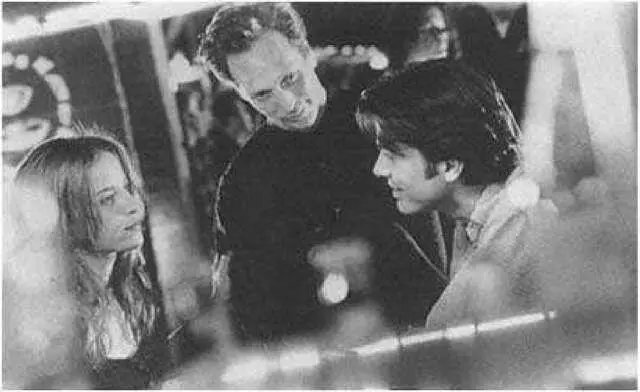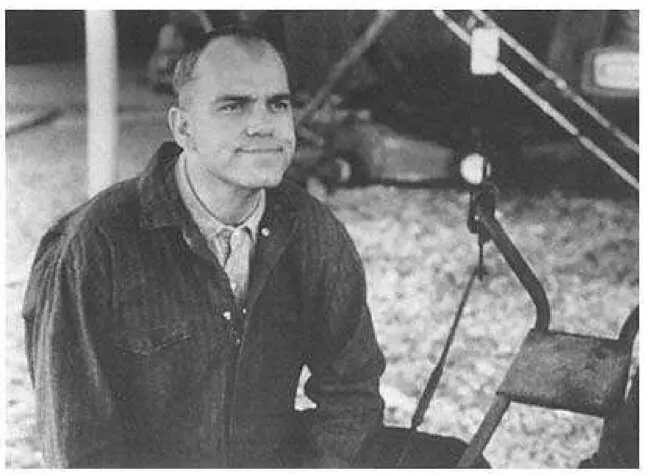Soderbergh's antihero, Michael Chambers, is a compulsive gambler who has run away from home to escape his debts. As the film begins, we see him returning after a long absence, finding a job as an armored-car driver, reading self-help books, and attempting to reestablish connections with the people he left behind. His policeman brother (Adam Trese) envies and despises him; his widowed, still attractive mother (Anjanette Comer), who has always favored him, is about to marry a boring but dependable man (Paul Dooley); and his former lover Rachel (Alison Elliot), whom he abandoned, is living with a sadistic and intensely jealous small-time gangster (William Fichtner). As in the 1949 production, the plot concerns a deadly triangle between Michael, Rachel, and the gangster, who become duplicitous allies in a robbery scheme. In this case, however, a fourth character is introduceda sweetly pretty young woman named Susan (Elizabeth Shue), who is attracted to Michael, and with whom he has a casual affair. Soderbergh also adds a new development to the conclusion, making the film seem a bit more in tune with the 1990s: Rachel tricks Michael into killing the gangster and then leaves Michael behind to die, reminding him before she goes that he once abandoned her. After all these years, she says, she has begun to understand "the appeal of walking away."
Michael Chambers emerges from the film as an ineffectual, superficially attractive character who finds himself sliding into a trap of his own making. In several respects, he resembles his mother and Rachel, both of whom are caught in unhappy, small-town relationships, and both of whom are petty gamblers, obsessively playing the Texas lottery. Actually, everyone in the film lives a life of quiet desperation, grasping at vague hope for a jackpot. If this malaise is not immediately apparent, that is because The Underneath, like Criss Cross, presents most of the action from Michael's point of view, using flashbacks and bizarre camera angles to heighten the sense of individual neurosis. The hospital sequence creates a truly Kafkaesque atmosphere of paranoia and black comedy, with the characters at Michael's bedside viewed subjectively through an extreme wide-angle lens, and the set designed in asymmetrical, Caligari fashion. 10(At one point during the subsequent kidnapping, the world turns completely upside down.) Although Soderbergh abandons the 1940s convention of subjective, voice-over narration, he experiments quite effectively with a visual stream of consciousness, creating a good deal of spatial and temporal disorientation. In the opening sequence, for instance, we see Michael through the green windshield of an armored car as he drives along a highway; then we see him in the back seat of a taxicab, gazing unhappily out the window; then we see a conversation between him and Susan aboard a Greyhound bus, where he once again sits alone beside a window. The chronology of these images is not clear, and there is a disjunction between sound and visuals; thus we hear the conversation aboard the bus before it appears on the screen, and we continue to hear it over a shot of Michael and Susan as they part company at their destination.

Noir remade: Alison Elliot, William Fichtner, and Peter Gallagher in The Underneath (1995).
(Museum of Modern Art Stills Archive.)
Throughout, The Underneath keeps its audience slightly off balance, joining the conventions of historical film noir with the more complex modernism of a New Wave director like Alain Resnais. Soderbergh's greatest strengths, however, are at the level of realist character and mood (especially in scenes involving repressed sexual tension), and for that reason the mechanics of the crime-movie plot keep overriding or frustrating his film's more interesting qualities. The problem is especially evident in the last scene. As she drives off with the stolen loot, leaving Michael to ponder his wasted life, Rachel stops at a convenience store to buy groceries and a lottery ticket; in the parking lot, we see the boss of the armored-car company (Joe Don Baker), who has been secretly responsible for financing the entire robbery scheme and who now plans to murder Rachel. This blatantly ironic twist is out of keeping with the wit and obliqueness of the earlier parts of the film. Even though it reinforces the recurring themes of gambling and failure, it makes the narrative as a whole seem too pat or genericin one sense, too faithful to noir.
Example 2: No such problem affects Billy Bob Thornton's Sling Blade (1997), which was not marketed or reviewed as a noir, although it easily could have been. Thornton, the writer, director, and star of the film, previously cowrote and acted in One False Move (1994), an exciting low-budget thriller set in rural Arkansas. He also wrote and acted in "Some Folks Call It a Sling Blade" (1993), a sinister, black-and-white short subject directed by George Hickenlooper, which was rephotographed in color and with different camera angles to make up the opening sequences of Sling Blade. Reviewers have described the completed feature-length version of this story as "Faulknerian"a somewhat strained comparison that nevertheless properly evokes Thornton's interest in southern gothicism. (We should recall that William Faulkner himself was a noir novelist and that some of the classic films noirs, including Frank Borzage's Moonrise [1949], are set in the rural South.) Indeed, had the Miramax distribution company been given their way, Sling Blade would probably have looked even more noirlike. It was shot in only twenty-four days for a cost of 1.3 million dollars and was originally intended as a sort of regional art movie for the video stores; Miramax, however, paid ten million for the rights and wanted to speed up the action along more commercial lines. Fortunately, Thornton resisted; as a result, he was able to explore certain "dark" motifs in a theatrical venue while avoiding a generic classification.
Sling Blade is a straightforward narrative performed at a deliberate, contemplative pace that seems anathema in contemporary Hollywood. Using long takes and a relatively static camera, photographer Barry Markowitz shoots the film chiefly with available light, immersing the interiors in a musty gloom and often illuminating figures with a single table lamp. This style is perfectly keyed to the central charactera slow-witted loner named Karl Childers (Thornton), who, when he was quite young, murdered his mother and her lover with a garden tool. During his childhood, Karl was locked in a shed by his parents and at one point was forced by his father to bury the still living body of his newborn brother. At the beginning of the film, he is pronounced "cured" and is released from the state mental hospital into the town where he was born, his only possessions a set of books that he has read over and over: the Bible, a story by Dickens ("that 'un about Christmas"), and some practical repair manuals. What follows is to some degree a sweetly comic wild-child story, involving Karl's attempt to adjust to the "big world" of laundromats, fast food, and low-budget supermarkets. During his wanderings about town, he befriends a small boy named Frank (Lucas Black), and he forms a bond with Frank's divorced mother, Linda (Natalie Canerday), and her closest friend, the gay manager of the store where she works (John Ritter). But Linda has an alcoholic boyfriend (Dwight Yoakum) who repeatedly bullies the group; as this character becomes more violent toward Frank, Karl's history threatens to repeat itself.

Art film or neo-noir? Billy Bob Thornton in Sling Blade (1996).
Читать дальше














